
Missouri River Institute
Center/InstituteLocated along the free-flowing Missouri National Recreational River, the Missouri River Institute explores the natural and cultural resources of the river through its focus on research, education and outreach.
Contact Us
414 E. Clark St.
Vermillion, SD 57069
8:00 a.m. - 5:00 p.m.
Studying a Rich and Extensive Ecosystem
The Missouri River Institute (MRI) focuses on research and education around the Missouri River Basin and its challenges. Our location on the 59-mile segment of the Missouri National Recreational River gives us unique access to this special section of river. Through outreach efforts, MRI educates the public on the history and cultural significance of the river.
A collaboration between faculty across USD, the MRI leverages a wide variety of expertise, including biology, chemistry, earth science, education, anthropology, media and journalism, history, computer science, business and law. Graduate and undergraduate students participate in river research and database programming. The institute is able to conduct research using its own boats and sampling equipment.
Our Partners
Faculty & Staff
Research
Goat Island Biodiversity
Goat Island is a 3.6 mile-long, 800-acre, island in the Missouri National Recreational River (MNRR) near Vermillion, South Dakota, ownership of which was formally transferred to the National Park Service as part of the MNRR in 2019. The island is vegetated by cottonwood riparian forest of various successional stages, with much of the older forest invaded by eastern red cedar. Sandbars and side-channel complexes also exist as part of the island complex. These varied habitats should provide for substantial biodiversity, but no systematic and comprehensive biodiversity surveys of the island have been previously undertaken. Given that the MNRR is currently implementing the approved management plan for Goat Island, surveys of biodiversity on the island would be beneficial for current and future adaptive management of the Goat Island property.
Several MRI faculty and student interns are involved in a project, funded by the National Park Service, to study the biodiversity of Goat Island. These studies involve biodiversity surveys for terrestrial vegetation, aquatic macro-invertebrates, fish, amphibians, and birds, on the Goat Island property using standard survey protocols for these floral and faunal groups. Surveys initially occurred in 2021 and some will be repeated in 2022. Information gained from these surveys will serve as a baseline for future adaptive management efforts and restoration projects on Goat Island, other MNRR properties, and elsewhere on the Missouri River. This project represents the highest natural resource priority for the MNRR as it serves as a unique opportunity to monitor biodiversity of a recent addition to the MNRR property portfolio.
Contact: [email protected]
Mapping Social Values Toward Land Use in the Upper Missouri River Basin
In a project funded by the National Science Foundation, Dr. Meghan Jarchow, along with postdoctoral fellow Dr. Amin Rastandeh and graduate student Morgan Carnes, studied the land use values of residents of the Upper Missouri River Basin (UMRB) to provide a picture of public attitudes toward desirable land uses and land features (LULFs) for the future of the UMRB. The study also examined whether residents’ desires are correlated with the socioenvironmental conditions of their landscapes. The authors conducted a survey of residents in 22 human population centers (HPCs), generated a ranking of residents’ desired LULFs, and performed a correlation analysis of the relationship between the scores dedicated to LULFs and 24 variables linked to socioenvironmental conditions of landscapes. The results indicate that there was strong agreement among residents of the UMRB about the most desirable LULFs despite large socioenvironmental differences across the region. Agriculture was generally found to be among the most desirable LULFs in the UMRB, but it was especially desirable in rural communities. LULFs related to development and energy had more variable responses and were among the least desirable LULFs in the UMRB. Hunting was more desirable in HPCs surrounded by grasslands and public lands. Overall, non-monetary LULFs were more strongly valued when looking into the future. In conclusion, the future that residents desire to see on their landscapes is partly influenced by the current status of socioenvironmental conditions of their landscapes. Concurrently, these conditions, can be, to a large extent, the product of residents’ past and current activities on their landscapes. Thus, change in residents’ desires depends on change in these conditions, and probably, vice versa.
Contact: [email protected]
Impact of Invasive Tree Species on Floodplain Bird Nesting Success along the Missouri National Recreational River
Floodplain forests, particularly those dominated by plains cottonwood (Populus deltoides), support among the highest levels of bird diversity of any habitat type in the Great Plains region, but native floodplain forests have been greatly reduced and degraded since the time of Euro-American settlement. These changes have promoted the invasion of floodplain forests by native upland and non-native tree species. These changes are likely to substantially impact breeding bird populations and nesting success, so we are investigating the influence of invasive tree species (principally Russian olive, Elaeagnus angustifolia, and eastern red cedar, Juniperus virginianus) on nesting success of birds in floodplain forest habitats along the Missouri National Recreational River.
The project involves finding and monitoring bird nests to determine nest fates for floodplain forest birds and comparing nest site selection and nesting success for bird species occupying habitats dominated by native and invasive trees and shrubs within floodplain forests along the Missouri River. Our comparisons of bird nesting success use statistical models to evaluate nesting success as a function of nest site and nest patch-level vegetation characteristics, including the preponderance of invasive tree species. The goal of the study is to determine important factors influencing nesting success for floodplain forest birds and the effect of invasive tree species on nest site selection and nest productivity. These data will help inform management decisions regarding invasive tree species and bird communities in Missouri River floodplain forests.
Contact: [email protected], University of South Dakota
MRI Faculty Contribute to a New Book on a Major Missouri River Tributary, the Big Sioux River
Former USD Biology M.S. student Matthew Ley and MRI Faculty Drs. Mark Dixon and David Swanson have contributed a chapter to the new 2022 book Heartland River: A Cultural and Environmental History of the Big Sioux River Valley, published by the Center for Western Studies at Augustana University. The title of the chapter is Land Use, Forests and Birds of the Big Sioux River Valley and the chapter content covers current land use and vegetation along the river, as well as changes since the time of European settlement. Most of the vegetation content in the chapter was based, in large part, on the M.S. thesis work of Mr. Ley, working under the supervision of Dr. Dixon at USD. The chapter also includes information on bird abundance and community structure in Big Sioux River riparian forests, along with comparisons of bird communities using Missouri River riparian woodlands. This work was conducted by former graduate students of Dr. Swanson at USD.
Contact: [email protected]
Impacts of Invasive Eastern Redcedar on Winter Birds Along the Missouri National Recreational River
Eastern redcedar (Juniperus virginiana L.) reaches the northwest extent of its range in southeastern South Dakota, occurring naturally in upland areas. It was likely scarce in frequently flooded riparian habitats along the Missouri River prior to the construction of dams and initiation of flow regulation in the mid-20th century. Over the last 60+ years, however, redcedar has invaded the cottonwood-dominated riparian forests along the Missouri River in eastern South Dakota and increased its density and distribution within the state. Establishment of redcedar in wooded riparian habitats may also lower native plant species richness, change floodplain forest structure, and affect wildlife habitat. Therefore, mapping the structure of redcedar-invaded riparian forests will aid in forest monitoring, inform redcedar management practices, and help determine the influence of redcedar expansion on riparian forest birds. Several bird species that were formerly very rare in winter in South Dakota now occur regularly in winter in the state and most of these species consume redcedar cones and may also benefit from thermal cover provided by redcedar during the winter. Increasing redcedar abundance in the region might have contributed to the increase in winter abundance of these species. Other bird species that eat fruits in winter might also respond positively to the increasing redcedar abundance and contribute to redcedar propagule dispersal.
In a project funded by the South Dakota Department of Game, Fish and Parks, MRI faculty Drs. Mark Dixon and David Swanson, along with Ph.D. student Nadeesha Illeperuma, are investigating the influence of redcedar expansion on richness, abundance, and habitat requirements of winter birds along the riparian forests of the Missouri National Recreational River (MNRR). The project will use remote sensing-derived LiDAR (Light Detection and Ranging) data and winter NDVI (“greenness”) maps from satellite imagery to determine redcedar and riparian forest structure and investigate their influence on winter bird biodiversity within the Missouri National Recreational River (MNRR). Standard point counts of winter birds were conducted across 36 points that span a gradient of redcedar density during the winter of 2021-2022 and these surveys will be repeated in the winter of 2022-2023. The project will use mapping of fine-scale forest structure to identify areas of high redcedar cover. Based on forest structure and bird survey data, the project will employ machine learning techniques to describe forest structure and redcedar densities across the MNRR, including surrounding bird survey points. This will allow us to document which vegetation structural variables, with special reference to redcedar, are important to winter bird abundance and biodiversity. Combined with previous data collected by MRI faculty and students on breeding and migratory birds in riparian forests along the MNRR, the findings of the proposed study will allow a comprehensive assessment of redcedar effects on bird biodiversity throughout the full annual cycle. As such, these data will play a key role when natural resource agencies (e.g., the National Park Service (MNRR) and the U.S. Army Corps of Engineers) plan their strategies to maintain natural habitats by controlling redcedar expansion along the MNRR.
Contact: [email protected]
Assessment of Land Cover Change and Cottonwood Forest Structure along the Missouri River
This project describes the current status, past changes and future projections for cottonwood forests along the Missouri River, from Montana to Missouri.
Key components of the project include:
- Use of GIS with current and historical imagery to quantify floodplain land cover, historic change and present-day cottonwood area and age distribution.
- Vegetation sampling to assess species composition and age structure of remnant cottonwood forest stands.
This project uses land cover change analyses and vegetation sampling to forecast future changes in cottonwood forest area, composition and age structure within the Missouri River floodplain.
Contact: [email protected], University of South Dakota
Aquatic-Terrestrial Subsidies within Riparian Ecosystems of the MNRR
Adult aquatic insects represent an important dietary subsidy for terrestrial birds living in riparian forests along the Missouri River. However, the importance of aquatic insects to diets of riparian forest birds depends not only on the quantity of insects available, but also on the quality of insects. For example, aquatic insects obtain polyunsaturated omega-3 fatty acids (PUFAs) from their algal-based diet, thereby making these essential PUFAs available to riparian birds that eat the aquatic insects. Including PUFAs in bird diets improves their flight performance and reproductive capacities. Diets based on terrestrial plant food webs do not contain PUFAs. As a result, terrestrial insects may have lower food quality than aquatic insects.
MRI faculty Drs. Jeff Wesner and David Swanson and several student interns will monitor aquatic insect emergence at several backwater and side-channel sites along the MNRR, including study sites at Goat Island, collect terrestrial arthropod samples by standard techniques and collect birds by mist net at these same sites. For bird sampling, we will capture birds at different distances from backwater/side-channel habitat and collect small blood samples. We will collect fatty acid composition data from emergent aquatic insects, terrestrial arthropods and bird red blood cells and compare PUFAs between aquatic insects emerging from the Missouri River, terrestrial insects in the adjacent riparian habitat, and membranes of bird red blood cells. The results of this study will determine the importance of aquatic insects in riparian bird diets and their contribution as sources of dietary PUFAs to terrestrial riparian insectivores. Given the decline in side-channel and backwater habitats along the Missouri River, which are important sources of aquatic insect emergence, an analysis of the importance of such insects to riparian bird diets is an important element for conservation and management of both aquatic and terrestrial ecosystems in the MNRR.
Contact: [email protected]
Making an Impact
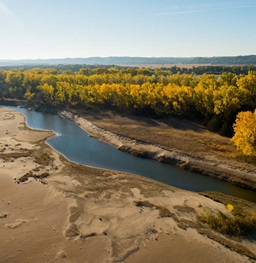
Sharing the Stories of the River
The impact of development along the river can best be understood by hearing the stories of the people who witnessed the change. The MRI documented oral histories of more than 30 long-time Missouri River residents to document the pre-development conditions and how that changed after dams were constructed. The interviews help to guide conservation efforts and provide insight into the local culture. All interviews are digitally archived at the USD Oral History Center and National Park Service Archives.
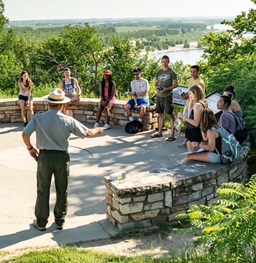
Missouri River Research Symposium
Thursday, November 13, 2025; 9 a.m. – 5 p.m.
The annual Missouri River Institute symposium at the University of South Dakota will feature several speakers describing research and management activities focused on issues related to the Missouri River and its basin.
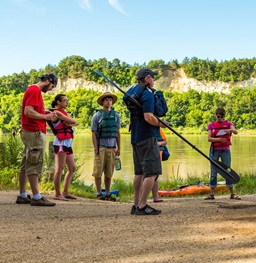
Knowledge Through Education
The Missouri River Institute offers courses on river studies and the science, culture and history of the Missouri River at the University of South Dakota. Close proximity to the Missouri River allows for field trips, active discussion and hands-on learning as students and faculty explore one of our greatest natural resources.
Departments & Facilities
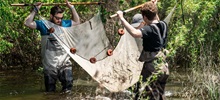
Biology
Research, explore and experience the study of life from the molecule to large biomes in the Department of Biology.

Sustainability & Environment
The field of sustainability invites us to examine the world we live in and imagine the possibilities for a brighter future. Find solutions to some of the world's most pressing challenges through the Department of Sustainability & Environment.

History
At the University of South Dakota, our Department of History houses numerous disciplines that exist at the intersection of curiosity, research, writing, storytelling and the human experience. Find the answers to your questions about people, events, institutions and values with the guidance and support of our exceptional faculty.

Media & Journalism
Media connects us to each other and our world. Explore the art of storytelling and media marketing through the Department of Media & Journalism.
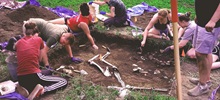
Anthropology & Sociology
Human behavior. Biology. Culture. Societies. Social change. Explore what brings us together and what makes us unique on biological and social levels through the Department of Anthropology & Sociology.

Chemistry
USD Chemistry is a tight-knit community of scholars. Undergraduates, graduate students, post-docs, and faculty work together in the classroom and the laboratory to solve some of today's biggest challenges in health, energy and the environment.

Computer Science
Learn to develop and manage technology that changes the world in the Department of Computer Science.












